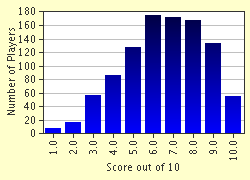Quiz Answer Key and Fun Facts
1. "This story is way too morbid - teenagers in war, gas attacks, barbed wire, grenades, death ... no one will read it."
2. "Who could identify with this hero? He kills an old pawnbroker and her sister, is sentenced to Siberia, considers suicide, and falls in love with a prostitute."
3. "Who wants to read about a bunch of goofballs (30, to be exact) in a bar telling outlandish stories? One of them is supposed to be a knight, but he's wearing a skirt!"
4. "The whole book is about some guys trying to blow up some stupid bridge!"
5. "Who can sympathize with this main character? He's a loser who gets drunk and sells his own wife and daughter, then spends the rest of the book whining about it!"
6. "This story is completely unbelievable. Three idiots are sent to hell and choose to stay there!"
7. "This one either sounds like a country song or one of those TV talk shows. The mother is dying and wants to watch her coffin being made; the father gets remarried and gets new teeth as soon as his wife dies; the daughter is pregnant and gets what she thinks is an abortion pill, but it's a placebo; and the dopey sons nearly lose their mother's coffin, with her in it, in a fire and by dropping it into the river."
8. "This is way too depressing - the heroine is executed at the end. She is seduced by a scoundrel who impregnates her and she names the child Sorrow, of all things! Then the baby dies! Then she marries who she thinks is Mr. Right, but he leaves her to start a farm. She finds another lover, whom she stabs to death."
9. "There are two problems with this novel. First, it's set in the future, which people can't relate to. More important, the bad guys are firemen - nobody wants to read a book in which the firemen are the bad guys."
10. "Yuck! Who wants to read about a dirty old man who has an affair with his preteen step-daughter?!"
Source: Author
bullymom
This quiz was reviewed by FunTrivia editor
MotherGoose before going online.
Any errors found in FunTrivia content are routinely corrected through our feedback system.

